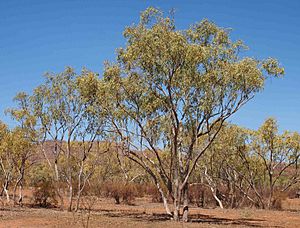Cloncurry box facts for kids
Quick facts for kids Cloncurry box |
|
|---|---|
 |
|
| Scientific classification | |
| Genus: |
Eucalyptus
|
| Species: |
leucophylla
|
| Synonyms | |
|
Eucalyptus tropica Cambage ex Maiden |
|
The Eucalyptus leucophylla, also known as the Cloncurry box, is a special tree. It can also grow as a mallee, which is a shrubby type of eucalyptus. This plant is mostly found in northwest Queensland, Australia. Some small groups might also grow in the eastern Kimberley area of Western Australia. It has rough, cracked bark and long, narrow leaves. Its flowers are creamy white, and its fruit looks like a small cup.
Contents
What the Cloncurry Box Looks Like
The Cloncurry box is a tree or a mallee. It usually grows up to 6 meters (about 20 feet) tall. It has a special woody swelling at its base called a lignotuber. This helps the plant regrow after fires.
Its bark is rough and greyish. It has tiny cracks all over the trunk and branches. Young plants and new shoots have dull, lance-shaped leaves. These leaves are about 6.5 to 12 cm long. They are also about 3.5 to 5 cm wide.
Older leaves are a dull light green or grey. Both sides of the leaf look the same. They are 8 to 14 cm long and 1.2 to 2.6 cm wide. Each leaf narrows down to a stalk called a petiole, which is 0.6 to 2 cm long.
Its flower buds usually grow in groups of seven. They appear where the leaves meet the stem. These groups of buds grow on a short stalk called a peduncle, which is 0.4 to 1 cm long. Each individual bud has its own tiny stalk, called a pedicel, which is 0.2 to 0.6 cm long.
The mature buds are oval or pear-shaped. They are about 0.6 to 0.7 cm long and 0.3 to 0.4 cm wide. They have a cone-shaped or rounded cap called an operculum. This cap protects the flower parts inside.
Cloncurry box flowers have been seen in March and August. The flowers are a lovely creamy-white color. After flowering, the plant produces fruit. The fruit is usually a woody, cup-shaped capsule. It is 0.4 to 0.7 cm long and 0.5 to 0.6 cm wide. The parts that release the seeds are usually level with the rim of the fruit.
How it Got its Name
The Cloncurry box was first officially described in 1928. A botanist named Karel Domin gave it the scientific name Eucalyptus leucophylla. He wrote about it in a book called Bibliotheca Botanica.
The name leucophylla comes from ancient Greek words. Leukos (λευκός) means "white." Phyllon (φύλλον) means "leaf." So, leucophylla means "white leaf." This name likely refers to the dull, light green or greyish color of its leaves.
Where the Cloncurry Box Lives
You can often find the Cloncurry box growing on low hills and in valleys. It grows in open woodland areas. It often shares its home with other trees like Corymbia terminalis or Eucalyptus leucophloia. You might also see it with Eucalyptus pruinosa.
Underneath these trees, you can often find smaller plants. These include Acacia hilliana and Triodia grasses. The Cloncurry box is mainly found in northwest Queensland. This includes areas near Camooweal, Mt Isa, Cloncurry, and Kajabbi.
The Cloncurry box is very similar to other types of eucalypts. These include E. limitaris and E. xerothermica. These similar trees grow in the Kimberley region of Western Australia. Because they look so alike, it can sometimes be hard to tell them apart.
In Queensland, E. leucophylla was once known by a different name. It used to be called Eucalyptus argillacea.
Conservation Status
The Queensland Government has looked at the Cloncurry box. They have classified this eucalypt as being of "least concern." This means that it is not currently considered to be at risk of disappearing.

